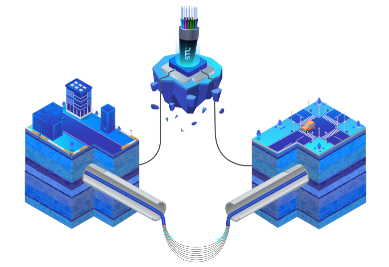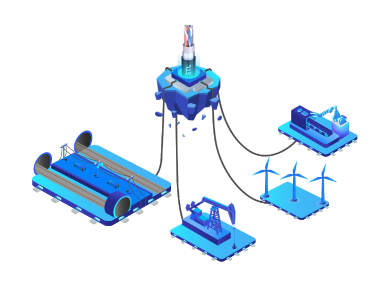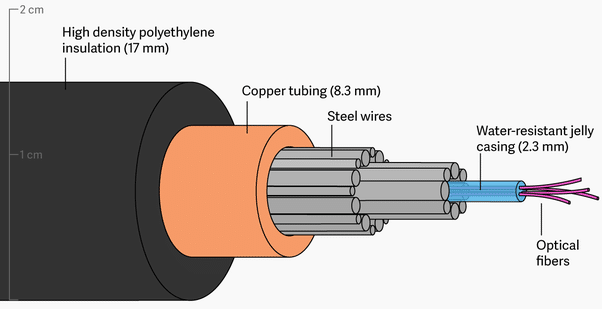Optical fibre cables have several optical fibres bundled together, which are usually covered in individual protective covers to reduce losses and damage. These cables are used to transfer data signals in the form of light pulses to distances of hundreds of miles with higher bandwidth and throughput rates than achievable via standard electrical communication cables. Read More..










Data is sent across fiber-optic cables using light pulses that move quickly. The center fiber is encircled by yet another layer of glass, referred to as the “cladding,” which forces light to constantly bounce off the walls of the cable instead of leaking out at the edges, allowing the photon to travel further without attenuation. Light moves down fiber-optic cables by frequently bouncing off the surfaces. The way a bobsleigh travels down an ice run, each small photon (particle of light) bounces down the pipe. Read More..


Built on STL's patented bend insensitive fibre technology and Microlite, Yogalite cables minimise installation time by 30%
 Catalogue
Catalogue
 Whitepaper
Whitepaper
 Case Study
Case Study
 Application Notes
Application Notes

Regarding the research we conducted using your company's fiber optical products, I would like to share my thoughts. We conducted a thorough investigation and can vouch for the superiority of STL's optical fiber solutions. Amazing technology was used to create the glass performance. The paperless quality processes and the use of KPIs for every single step left a lasting impression on us.
I'd want to take this chance to thank Sterlite Tech for everything they did to make our trip to your nation a truly amazing experience. I can't even begin to express how delighted we were with Sterlite Tech and all we saw at your glass and cable manufacturing facilities.
STL has a great crew and produces high-quality goods. The glass capabilities and optical cable infrastructure of STL are simply incredible. The fiber optic cables are of the highest caliber that our organization has ever used. We very much appreciate your products and services.

Fibre optics refers to the technology and the medium associated with the transmission of data as light pulses along a ultrapure strand of glass, which is a thin as a human hair.

Due to increasing data demands, there's a dire need to create new fibre deep networks and data centres, which would encourage faster 5G and FTTH adoption.

The world is getting smarter and connected. Converged and high bandwidth application networks have unique challenges which make high performance connectivity a top priority.
An optical fiber network uses infrared light pulses to transport information over optical fiber from one location to another. The carrier wave that makes up light is modified to transmit information. Broadband connections that use fiber-optic technology can provide lag-free rates of up to 940 megabits per second (Mbps). Fiber-optic internet is also known as "fibre" internet or simply "fiber." The system makes use of fiber-optic cable, which astonishingly has a data transmission rate of up to 70% of the speed of light. Additionally, fiber-optic cables are less vulnerable to extreme weather than other older cable types, reducing disruptions. Additionally, it successfully withstands electrical interference.
Based on the mode of propagation of light, optical fiber cables have two different types.
a. Multimode Optical Fiber Cable: At wavelengths of 850 nm or 1300 nm, multimode fiber (MMF) enables the simultaneous transmission of several data streams.
b. Singlemode Optical Fiber Cable: Singlemode fiber (SMF) has a single light route that can traverse great distances and has a significantly smaller core size.
Based on materials, optical fiber cables are divided into two types.
a. Plastic Optical Fiber Cable: The main substance for light transmission is poly(methyl methacrylate).
b. Glass Optical Fiber Cable: It is made out of a mass of glass fibers. Light travels through each individual glass fiber from the light source to the fiber's opposite end.
Lastly, based on the refractive index, optical fiber cable is divided into two different types.
a. Step-Index optical fiber cable: Step-index fibers feature a symmetrical core with one index of refraction and a lesser index of refraction on the uniform cladding. The simplest type of optical fiber has a cylindrical silica glass core that is encircled by cladding with a lower refractive index than the core.
b. Graded-Index optical fiber cable: As the radial distance from the fiber axis rises, the optical fiber's refractive index falls. Graded-index fibers are often utilized in the telecom industry by grading the index of refraction of the core such that it gradually tapers between both the core center and the cladding. It lowers multimode dispersion.
a. Based on construction, Multimode permits many concurrent light modes, whereas single-mode fiber is meant to transport a single light mode. The bandwidth, signal stability, and signal transmission distance are all impacted by this disparity.
b. Based on bandwidth, Single mode cables may accommodate more powerful, brighter light sources with less attenuation. Comparatively, Multimode relies on the transmission of several light modes with increased attenuation and lower brightness.
c. Based on transmission distance, With a typical single-mode connection, single-mode fiber can transport data across short and long distances of up to 10 km (6.2 miles). On the other hand, the maximum transmission distance for multimode ranges from 300 to 550 meters.
The fastest and most dependable internet service right now is fiber optic. Users may access more media types and larger file sizes more quickly because of the fiber's quicker download and upload rates. Tech experts now choose it over the 5G network because it is quicker and more dependable. A fiber network can easily meet all of your internet demands, thanks to speeds up to 100 times faster than standard broadband. The bandwidth of fiber optics is 1 GB/s. That's 10-20 times faster than the 50-100 Mbps cable that most of us are familiar with today.
The technique that sends information as light pulses via a glass or plastic fiber is known as fiber optics, often called optical fiber. These glass fibers can range in quantity from a few to several hundred in a fiber optic cable. The glass fiber core is encircled by a second glass layer known as cladding. A few to hundreds of optical fibers may be found inside the plastic sheath of a fiber-optic cable. They transmit data signals in the form of light and travel hundreds of miles more quickly than those used in conventional electrical cables. Optic cables and optical fiber cables are other names for them.
Please wait while you are redirected to the right page...
